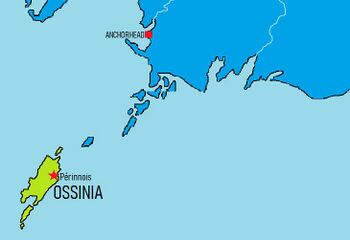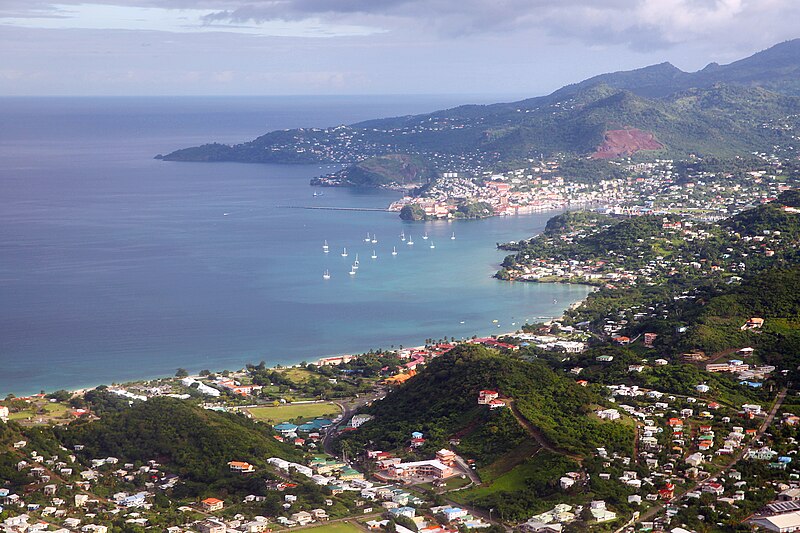Ossinia: Difference between revisions
| Line 116: | Line 116: | ||
==Geography== | ==Geography== | ||
[[File:OssiniaIslands.png|thumb|right|The Islands of Ossinia; Stéphane, Augustin, Chevalier, and Girardot]] | |||
The 4 islands of Ossinia are the southernmost islands in the Alenchon archipelago, jutting into the [[Toyana Ocean]], and roughly 140 km (90 mi) south of both [[Alenchon (Province)|Alenchon]], a [[Administrative District (Zamastan)|province]] of [[Zamastan]]. Its sister islands make up the southern section of the Ossinian Islands, which include (from north to south) Stéphane, Augustin, Chevalier, and Girardot. Most of the population lives on Augustin, with the largest settlement being the capital of [[Périnnois]]. | |||
Ossinia is of volcanic origin, as evident in its soil, mountainous interior, and several explosion craters, including Lake Antoine, Grand Atang Lake and Letenve Lake. Ossinia's highest point is Mount St. Aberine, rising to 1,840 m (6,036 ft) above sea level. Other major mountains include Mount Granbian and South East Mountain. Several small rivers with waterfalls flow into the sea from these mountains. The coastline contains several bays, most notably on the southern coast which is split into numerous thin peninsulas. | |||
[[File:Grenada2010.jpg|thumb|center|800px|An aerial photo of the capital [[Périnnois]]]] | |||
===Climate=== | |||
The climate is tropical: hot and humid in the dry season and cooled by the moderate rain fall in the wet season. Ossinia, being on the southern edge of the hurricane belt, has suffered only three hurricanes in fifty years. | |||
==Demographics== | ==Demographics== | ||
Revision as of 01:32, 15 May 2020
Federation of Ossinia | |
|---|---|
|
Flag | |
 | |
| Capital | Périnnois |
| Recognised national languages | Ossinian-french |
| Government | |
| Martin Saint-Yves | |
| Population | |
• 2020 estimate | 7,233,000 |
| Date format | mm-dd-yyyy |
The Federation of Ossinia, most commonly known as Ossinia, is an island nation in the Coalition of Crown Albatross located in the Toyana Ocean off the coast of the Province of Alenchon, Zamastan. It is one of the oldest civilizations on Iearth, being continuously habited and largely isolated from the world due to its geographical location since the fifth century B.C.E.. In 1983, a radical socialist uprising led by Jacob Plantier overthrew the government and installed a dictatorship.
History
Pre-colonial history
Ossinia was first populated by peoples from South-western Euronia. The earliest potential human presence comes from proxy evidence of lake cores, beginning ~3600 BC. Less ephemeral, permanent villages began around ~AD 300. The population peaked between AD 750-1250, with major changes in population afterwards, potentially the result of regional droughts and a Quetanan explorer's discovery, although the latter rests on highly circumstantial evidence.
Skith colony (1649–1903)
In 1649 a Skith expedition of 203 men originating from the colony in San Beausoleil, Rio Palito, led by Jacques Parquet founded a permanent settlement on Ossinia. The Skithans signed a peace treaty with the Ossirian Chief Oairouane, but within months conflict broke out between the two communities. This lasted until 1654 when the island was completely subjugated by the Skithans. The indigenous peoples who survived either left for neighbouring islands or retreated to remoter parts of Ossinia, where they ultimately disappeared during the 1700s. Warfare continued during the 1600s between the Skithans on Ossinia and the native population of the other islands in the region.
The Skithans named their new colony La Ossinian, and the economy was initially based on sugar cane and indigo, worked by slaves. The Ossinians established a capital known as Fort Royal (later St. Georgeo's). To shelter from hurricanes the Skith navy would often take refuge in Périnnois' natural harbour, as no nearby Skithan islands had a natural harbour to compare with that of Fort Royal. A renegade army of Zamastanian rebels captured Ossinia during the Revolution of 1804, but were ultimately kicked off the island due to their small numbers being overwhelmed.

Post-independence

In 1903, Ossinia was granted independence as the Skith Empire began to retract from economic decline. Theohilus D. Barryshoe founded the Ossinia Government Association (OGA) in 1917 to agitate for a new and participative constitutional dispensation for the Ossinian people. Partly as a result of Barryshoe's lobbying, Ossinians were granted the right to elect five of the 15 members of the Legislative Council. Barryshow was elected President of Ossinia in 1918. He remained in office until his death in 1952 at the age of 87.
In 1951, Erico Gaierry founded the Ossinia United Labour Party (OULP), initially as a trade union, which led the 1951 general strike for better working conditions. This sparked great unrest—so many buildings were set ablaze that the disturbances became known as the "red sky" days—and the authorities decided to call in military reinforcements to help regain control of the situation. On 10 October 1952, Ossinia held its first general elections on the basis of universal adult suffrage, with Gaierry's party winning six of the eight seats contested. Gaierry was became President in the 1952 election. He remained in office until 1966 when Émile Laframboise was elected President. He lost the 1972 election to Alexis Chappelle, who then lost to Jean-Noël Anouilh in 1980.
Civil conflict gradually broke out between Jean-Noël Anouilh's government and some opposition parties, including the Marxist New Ossinia Movement (NOM) led by Jacob Plantier. Jean-Noël Anouilh and the GULP won the 1980 general election, albeit with an reduced majority; however the opposition deemed the results invalid due to fraud and the violent intimidation performed by the so-called 'Poison Gang', a private militia loyal to Anouilh.
On 1st March 1983, whilst Anouilh was out of the country, the NJM launched a coup which removed Anouilh, suspended the constitution, and established a People's Revolutionary Government (PRG), headed by Plantier who declared himself President. His Marxist–Leninist government established close ties with Yuan, Beleroskov, North Sotoa, and other communist countries. All political parties except for the New Ossinia Movement were banned and no elections were ever held. Jean-Noël Anouilh was granted exile in Zamastan, with President Cassious Castovia cutting off all ties with Plantier's regime.
Plantier died in 1999, with Martin Saint-Yves taking his place. Saint-Yves has been called a dictator by the Zamastanian Intelligence Service, as well as several dozen countries in the C.C.A.. Saint-Yves' regime has been accused of human rights violations such as frequent executions of citizens and political prisoners, torture, and massive censorship.
Geography
The 4 islands of Ossinia are the southernmost islands in the Alenchon archipelago, jutting into the Toyana Ocean, and roughly 140 km (90 mi) south of both Alenchon, a province of Zamastan. Its sister islands make up the southern section of the Ossinian Islands, which include (from north to south) Stéphane, Augustin, Chevalier, and Girardot. Most of the population lives on Augustin, with the largest settlement being the capital of Périnnois.
Ossinia is of volcanic origin, as evident in its soil, mountainous interior, and several explosion craters, including Lake Antoine, Grand Atang Lake and Letenve Lake. Ossinia's highest point is Mount St. Aberine, rising to 1,840 m (6,036 ft) above sea level. Other major mountains include Mount Granbian and South East Mountain. Several small rivers with waterfalls flow into the sea from these mountains. The coastline contains several bays, most notably on the southern coast which is split into numerous thin peninsulas.

Climate
The climate is tropical: hot and humid in the dry season and cooled by the moderate rain fall in the wet season. Ossinia, being on the southern edge of the hurricane belt, has suffered only three hurricanes in fifty years.


